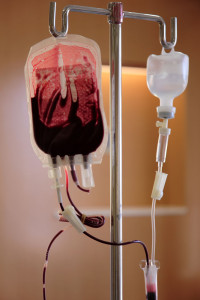Introduction
Anemia due to blood loss is a very common finding in the setting of general practice. When the physician spots a person with anemia and the blood tests show a microcytic anemia, the question is whether this is due to an acute blood loss or due to chronic blood loss. These two syndromes are two very different clinical conditions. This is why I deal with it here under two different headings. For one thing: an acute blood loss can lead to destabilization of the circulation very quickly resulting in shock. It requires very aggressive treatment. On the other hand an anemia from chronic blood loss allows the physician more time for a diagnostic work-up. While anemia due to chronic blood loss is not as acute, it may be due to a more sinister cause such as cancer.
Anemias Caused By Acute Blood Loss
This type of anemia is the result of a massive hemorrhage. Trauma to a large blood vessel and a massive hemorrhage can be the reason, on the other hand erosion of a blood vessel by a disease like a duodenal or stomach ulcer. With the use of blood thinners there may be a failure of bleeding to stop, a condition which can occur when a patient receives blood thinners for prevention of blood clots or as a precaution when irregular heart beats are present. Sudden loss of one third of the blood volume may be fatal.
Acute hemorrhages
Hemorrhages at a rapid pace cause more severe symptoms than a slower bleed. Despite the symptoms of dizziness, faintness, sweating and rapid pulse, the red blood count, hemoglobin and hematocrit may be high, because of the constriction of blood vessels. Within a few hours, the body attempts to replace the missing blood volume with tissue fluid, and at this point there will be a drop in the red blood count and the hemoglobin. As there is no change in the structure of the red blood cells, the anemia is called normocytic.
Treatment
The immediate necessity is the attempt to stop the bleeding (repair of a torn blood vessel). The blood volume has to be restored. Treatment for shock may be necessary. Infusions of plasma are the most suitable substitute for blood. Saline solution or dextrose solutions only have temporary benefits. The patient needs absolute rest and should receive fluids and other supportive treatment for shock. In addition iron supplement can be used to replace the iron that has been lost during the hemorrhage. When a large amount of blood has been lost in a short time, whole blood transfusions may be necessary.
Chronic Blood Loss Anemia
Causes
Prolonged moderate blood loss can cause this type of anemia. A bleeding stomach ulcer or hemorrhoids can be the culprits. Bleeding in the urinary tract or in female patients bleeding from the uterus can be the source of a microcytic anemia. Early changes in laboratory tests can be minimal. Under the microscope the blood cells look small; this is due to a chronic lack of iron.
Differential Diagnosis
There are different types of anemia besides the picture of microcytic anemia, including iron deficiency anemia, iron transport deficiency, iron utilization anemias, anemia of chronic disease, and thalassemia (anemia caused by defective hemoglobin synthesis.)
Iron Deficiency
Once the iron metabolism of the body is not working properly, iron deficiency anemia is the result. Normally the total body iron amounts to about 3.5 g in healthy males and 2.5 g in healthy adult females. Iron storage occurs in tissue cells as ferritin and hemosiderin. The average North American diet is normally adequate to meet the iron demands of the body. The best absorption of iron occurs, if the food source contains the “heme Fe”. This is iron that comes from a meat source. Non-heme Fe is frequently not as well absorbed, because some food items like bran and tannins in tea can reduce the absorption. Ascorbic acid (vitamin C) is the only food element that increases the bioavailability of non-heme Fe (iron from plant sources).
Body conserves iron
Of about 10mg/day of dietary iron, adults only absorb 1mg. Because iron absorption is so limited, the body has a mechanism to conserve. Aging red blood cells are undergoing a process called phagocytes by mononuclear phagocytes. It means that the body recycles old red blood cells to make the iron content available to the body. By reutilizing 97% of all iron in the body it satisfies its daily iron needs from this storage pool.
Diagnostic Tests
It is obvious that only laboratory tests will give information about the iron level and iron binding capacity. If the concentration of serum iron is low, it is a sign of iron deficiency and chronic disease. Elevated iron levels point to hemolytic conditions and iron overload disorders. Patients who are taking iron pills may have a normal serum iron level and yet have a deficiency. A patient can do a valid iron test only, if the patient stops iron therapy for 1 to 2 days. In iron deficiency the iron binding capacity is high: the body struggles to get more iron. In anemia of chronic disease iron-binding capacity is low. Ferritin levels that are low are always an indicator of iron deficiency.
Elevated ferritin
If ferritin is high the doctor may deal with a patient who has disease of the liver like hepatitis or some tumors, especially acute leukemia. Hodgkin’s disease and tumors of the gastrointestinal area may be present. Other items that are monitored are the serum transferrin receptor, red blood cell ferritin and free red blood cell protoporphyrin. Here is an illustration of the complex transferrin system.
Laboratory medicine in the area of blood disorders is extremely complex as laboratory methods have become sophisticated. As a result the input of a hematologist who specializes in the diagnosis and treatment of the multitude of blood disorders is often needed.
References
1. Merck Manual (Home edition): Anemia
2. Noble: Textbook of Primary Care Medicine, 3rd ed., Mosby Inc. 2001
3. Goldman: Cecil Medicine, 23rd ed., Saunders 2007: Chapter 162 – APPROACH TO THE ANEMIAS







